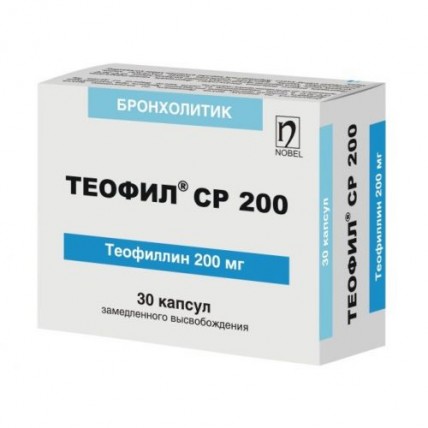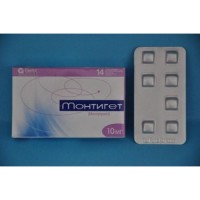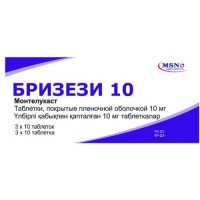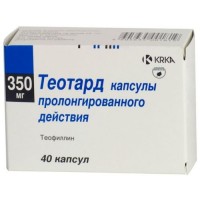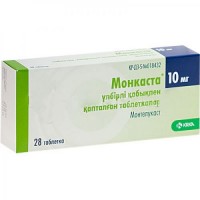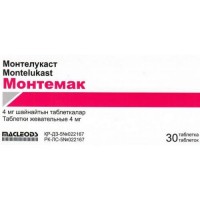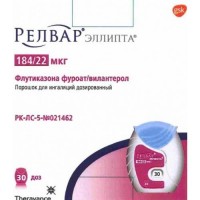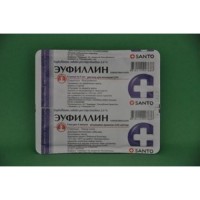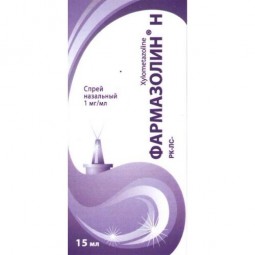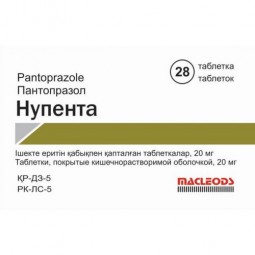Theophilus CP 30s 200 mg capsules
- $7.70
The instruction for use of medicine
for experts
of Teofil®
of CP 100 Teofil® CP 200 Teofil® CP 300
the Trade name
of Teofil®
of CP 100 Teofil® CP 200 Teofil® CP 300
the International unlicensed
name Theophylline Dosage Form
of the Capsule of 100 mg, 200 mg, 300 mg
Structure
One capsule contains
active agent - theophylline of 100 mg, 200 mg, 300 mg,
excipients: neutral micropellets, the bleached shellac,
talc
a gelatin capsule: E-122 azoruby (100 mg), E-132 indigo carmine (200 mg), quinolinic yellow E-104, patent blue V E-131 (300 mg), gelatin
Description
Solid gelatin capsules, body of capsules colourless and transparent, lids transparent pink color (100 mg), dark blue color (200 mg), green color (300 mg). Each capsule contains spherical micropellets of white or whitish color.
Pharmacotherapeutic group
Other drugs for treatment of bronchial asthma for system use. Xanthine derivatives.
The code of automatic telephone exchange R03DA04
the Pharmacological
Pharmacokinetics At properties intake theophylline is quickly and completely soaked up from digestive tract. Presence of food at a stomach can influence theophylline absorption speed and also its clearance.
The maximum concentration in plasma after administration of drug is inside reached 6-9 hours later. Protein-binding of plasma makes 60%, people with a disease of a liver have 20-40%. Theophylline moderately gets into fabrics, distribution volume near 0.5l/kg, well gets through a blood-brain barrier, a placenta and into breast milk.
Theophylline is metabolized in a liver for 90%. Elimination half-life of theophylline at non-smoking patients with bronchial asthma and without pathological changes from other bodies and systems makes 6-12 hours, smokers have 4-5 hours. Elimination half-life increases at elderly patients and at patients with heart failure and diseases of a liver. Elimination half-life of drug for children makes 1.5 hours. It is generally removed with urine. Duration of maintaining therapeutic concentration in blood fluctuates from 4 to 5 hours.
The pharmacodynamics
Theophylline suppresses activity of specific phosphodiesterases (FDE), stabilizes intracellular concentration of cyclic adenosinemonophosphate (tsAMF). Theophylline blocks receptors of adenosine and relaxes smooth muscles of bronchial tubes and blood vessels of lungs.
Theophylline stimulates a respiratory center of a medulla, increasing sensitivity to promoting effect of carbon dioxide.
Theophylline can reduce the hyperreactivity of airways connected with a late phase of the reaction caused by inhalation of allergens.
Theophylline increases number and activity of T-suppressors in peripheral blood.
Theophylline also expands peripheral, coronary and renal vessels, has moderate diuretic effect, inhibits aggregation of thrombocytes, slows down release from mast cells of mediators of an allergy. Theophylline has the stimulating impact on a cardiac muscle and on the central nervous system, causes vasoconstriction of a brain, increases contractility of a diaphragm, reduces resistance of pulmonary vessels, causes increase in secretion of acid in a stomach.
Indications
- bronchial asthma
- simtomatichesky treatment of a bronchospasm of various etiology (including in chronic obstructive pulmonary diseases, chronic bronchitis, emphysema of lungs)
- pulmonary hypertensia
- a pulmonary heart
- breath disorder as Cheyna-Stokes
- disturbance of cerebral circulation.
The route of administration and doses
use Drug orally. The mode of dosing are established individually.
For adults:
A single dose - 200 mg - 300 mg, a daily dose - 400 mg - 600 mg. The maximum single dose - 400 mg, the maximum daily dose - 600 mg
For children over 6 years:
A single dose - 100 mg, a daily dose - 200 mg. The maximum single dose-200 of mg, the maximum daily dose - 400 mg.
If improvement of a state is not observed, then the dose can be increased approximately by 25% each 3 days during time so far drug well is transferred.
Increase in a dose has to be made to the maximum doses provided below:
Age Dosage
of 6-9 years: 24 mg/kg a day
9-12 years: 20 mg/kg a day
12-16 years: 18 mg/kg a day
are also more senior than 16 years: 13 mg/kg a day or on 900 mg a day
As theophylline do not get to fatty tissues, it is necessary to determine a dose by weight strictly.
Effective use of theophylline (concentration of drug in serum depends on optimum advantage and minimal risk of intoxication) is reached at concentration of theophylline in serum from 10 to 20 mkg/ml.
To swallow capsules entirely, without opening and without chewing.
Side effects
- heartburn, nausea, vomiting, pains in epigastriums, diarrhea
- a headache, irritability, concern, insomnia, the increased reflex irritability, clonic and tonic spasms
- heartbeat, tachycardia, premature ventricular contraction, rushes of blood, hypotension, blood circulation disturbance, ventricular arrhythmia
- a tachypnea
- increase in a diuresis
- an alopecia, a hyperglycemia, a hypopotassemia, an itching,
Contraindication rash
- hypersensitivity to theophylline or to drug components
- epilepsy and other convulsive states
- hyperfunction of a thyroid gland
- an acute myocardial infarction
- a subaortal stenosis
- premature ventricular contraction
- a peptic ulcer of a stomach and duodenum in an aggravation phase
- children's age up to 6 years
- pregnancy.
Medicinal interactions
Theophylline exponentiates broncholitic action of beta2-adrenomimetik that allows to use the last in smaller doses. Theophylline increases clearance of lithium and a pyridoxine at joint appointment therefore their efficiency decreases at invariable concentration of drug in blood plasma. Concentration of theophylline in blood to decrease at simultaneous use with phenobarbital, rifampicin, an isoniazid, carbamazepine, Sulfinpyrazonum, Phenytoinum and also at smokers. Concentration of theophylline in blood increases at simultaneous use with antibiotics from group of macroleads, Allopyrinolum, beta blockers, Cimetidinum, hormonal oral contraceptives, izoprenaliny, lincomycin.
Theophylline can exponentiate the hypopotassemia caused by action of stimulators β2-адренорецепторов, corticosteroids and diuretics.
The special
instructions Level in serum higher than 10 mg/ml it was seldom observed after use recommended dosed Nevertheless, to people at whom the clearance of theophylline in plasma is reduced for any reason, even usual doses of theophylline can become the reason of increase in level in serum and potential toxicity. Reduced clearance of theophylline at the following groups of people:
1) patients with a liver and chronic pulmonary failure
2) patients are more senior than 55 years
3) patients with heart failure
4) patients with long fever
5) children are younger than 1 year
6) the patients taking other drugs entering interaction
with theophylline.
Theophylline has to be applied with care at patients with a peptic ulcer of a stomach and duodenum, also patients with cardiac arrhythmia, other cardiovascular diseases and a hyperthyroidism. Drug should not will be applied together with the drugs containing xanthine derivatives.
A lactation
It is necessary to consider that theophylline is emitted with breast milk. In case of need prescribing of drug in the period of a lactation it is asked about the breastfeeding termination.
To feature of influence of medicine on ability to run the vehicle or potentially dangerous mechanisms
it is not established.
Overdose
Symptoms:
The headache, nausea, vomiting, concern, hypotension, tachycardia, arrhythmia (usually supraventricular tachyarrhythmia), can arise spasms.
Treatment:
Gastric lavage, calling of vomiting and lavage. Use of activated carbon. Performing symptomatic treatment.
A form of release and packing
of the Capsule on 100 mg, 200 mg, 300 mg in blister No. 10 in a cardboard pack together with the instruction for use.
To Store storage conditions at a temperature from +15 °C to +30 °C in the dry, protected from light place.
To store out of children's reach!
3 years
not to apply an expiration date after an expiration date.
Prescription status
According to the prescription
Republic of Kazakhstan JSC Nobel Almatinskaya Pharmatsevticheskaya Fabrika Producer
Almaty, Shevchenko St. 162 E.
To develop
for experts
of Teofil®
of CP 100 Teofil® CP 200 Teofil® CP 300
the Trade name
of Teofil®
of CP 100 Teofil® CP 200 Teofil® CP 300
the International unlicensed
name Theophylline Dosage Form
of the Capsule of 100 mg, 200 mg, 300 mg
Structure
One capsule contains
active agent - theophylline of 100 mg, 200 mg, 300 mg,
excipients: neutral micropellets, the bleached shellac,
talc
a gelatin capsule: E-122 azoruby (100 mg), E-132 indigo carmine (200 mg), quinolinic yellow E-104, patent blue V E-131 (300 mg), gelatin
Description
Solid gelatin capsules, body of capsules colourless and transparent, lids transparent pink color (100 mg), dark blue color (200 mg), green color (300 mg). Each capsule contains spherical micropellets of white or whitish color.
Pharmacotherapeutic group
Other drugs for treatment of bronchial asthma for system use. Xanthine derivatives.
The code of automatic telephone exchange R03DA04
the Pharmacological
Pharmacokinetics At properties intake theophylline is quickly and completely soaked up from digestive tract. Presence of food at a stomach can influence theophylline absorption speed and also its clearance.
The maximum concentration in plasma after administration of drug is inside reached 6-9 hours later. Protein-binding of plasma makes 60%, people with a disease of a liver have 20-40%. Theophylline moderately gets into fabrics, distribution volume near 0.5l/kg, well gets through a blood-brain barrier, a placenta and into breast milk.
Theophylline is metabolized in a liver for 90%. Elimination half-life of theophylline at non-smoking patients with bronchial asthma and without pathological changes from other bodies and systems makes 6-12 hours, smokers have 4-5 hours. Elimination half-life increases at elderly patients and at patients with heart failure and diseases of a liver. Elimination half-life of drug for children makes 1.5 hours. It is generally removed with urine. Duration of maintaining therapeutic concentration in blood fluctuates from 4 to 5 hours.
The pharmacodynamics
Theophylline suppresses activity of specific phosphodiesterases (FDE), stabilizes intracellular concentration of cyclic adenosinemonophosphate (tsAMF). Theophylline blocks receptors of adenosine and relaxes smooth muscles of bronchial tubes and blood vessels of lungs.
Theophylline stimulates a respiratory center of a medulla, increasing sensitivity to promoting effect of carbon dioxide.
Theophylline can reduce the hyperreactivity of airways connected with a late phase of the reaction caused by inhalation of allergens.
Theophylline increases number and activity of T-suppressors in peripheral blood.
Theophylline also expands peripheral, coronary and renal vessels, has moderate diuretic effect, inhibits aggregation of thrombocytes, slows down release from mast cells of mediators of an allergy. Theophylline has the stimulating impact on a cardiac muscle and on the central nervous system, causes vasoconstriction of a brain, increases contractility of a diaphragm, reduces resistance of pulmonary vessels, causes increase in secretion of acid in a stomach.
Indications
- bronchial asthma
- simtomatichesky treatment of a bronchospasm of various etiology (including in chronic obstructive pulmonary diseases, chronic bronchitis, emphysema of lungs)
- pulmonary hypertensia
- a pulmonary heart
- breath disorder as Cheyna-Stokes
- disturbance of cerebral circulation.
The route of administration and doses
use Drug orally. The mode of dosing are established individually.
For adults:
A single dose - 200 mg - 300 mg, a daily dose - 400 mg - 600 mg. The maximum single dose - 400 mg, the maximum daily dose - 600 mg
For children over 6 years:
A single dose - 100 mg, a daily dose - 200 mg. The maximum single dose-200 of mg, the maximum daily dose - 400 mg.
If improvement of a state is not observed, then the dose can be increased approximately by 25% each 3 days during time so far drug well is transferred.
Increase in a dose has to be made to the maximum doses provided below:
Age Dosage
of 6-9 years: 24 mg/kg a day
9-12 years: 20 mg/kg a day
12-16 years: 18 mg/kg a day
are also more senior than 16 years: 13 mg/kg a day or on 900 mg a day
As theophylline do not get to fatty tissues, it is necessary to determine a dose by weight strictly.
Effective use of theophylline (concentration of drug in serum depends on optimum advantage and minimal risk of intoxication) is reached at concentration of theophylline in serum from 10 to 20 mkg/ml.
To swallow capsules entirely, without opening and without chewing.
Side effects
- heartburn, nausea, vomiting, pains in epigastriums, diarrhea
- a headache, irritability, concern, insomnia, the increased reflex irritability, clonic and tonic spasms
- heartbeat, tachycardia, premature ventricular contraction, rushes of blood, hypotension, blood circulation disturbance, ventricular arrhythmia
- a tachypnea
- increase in a diuresis
- an alopecia, a hyperglycemia, a hypopotassemia, an itching,
Contraindication rash
- hypersensitivity to theophylline or to drug components
- epilepsy and other convulsive states
- hyperfunction of a thyroid gland
- an acute myocardial infarction
- a subaortal stenosis
- premature ventricular contraction
- a peptic ulcer of a stomach and duodenum in an aggravation phase
- children's age up to 6 years
- pregnancy.
Medicinal interactions
Theophylline exponentiates broncholitic action of beta2-adrenomimetik that allows to use the last in smaller doses. Theophylline increases clearance of lithium and a pyridoxine at joint appointment therefore their efficiency decreases at invariable concentration of drug in blood plasma. Concentration of theophylline in blood to decrease at simultaneous use with phenobarbital, rifampicin, an isoniazid, carbamazepine, Sulfinpyrazonum, Phenytoinum and also at smokers. Concentration of theophylline in blood increases at simultaneous use with antibiotics from group of macroleads, Allopyrinolum, beta blockers, Cimetidinum, hormonal oral contraceptives, izoprenaliny, lincomycin.
Theophylline can exponentiate the hypopotassemia caused by action of stimulators β2-адренорецепторов, corticosteroids and diuretics.
The special
instructions Level in serum higher than 10 mg/ml it was seldom observed after use recommended dosed Nevertheless, to people at whom the clearance of theophylline in plasma is reduced for any reason, even usual doses of theophylline can become the reason of increase in level in serum and potential toxicity. Reduced clearance of theophylline at the following groups of people:
1) patients with a liver and chronic pulmonary failure
2) patients are more senior than 55 years
3) patients with heart failure
4) patients with long fever
5) children are younger than 1 year
6) the patients taking other drugs entering interaction
with theophylline.
Theophylline has to be applied with care at patients with a peptic ulcer of a stomach and duodenum, also patients with cardiac arrhythmia, other cardiovascular diseases and a hyperthyroidism. Drug should not will be applied together with the drugs containing xanthine derivatives.
A lactation
It is necessary to consider that theophylline is emitted with breast milk. In case of need prescribing of drug in the period of a lactation it is asked about the breastfeeding termination.
To feature of influence of medicine on ability to run the vehicle or potentially dangerous mechanisms
it is not established.
Overdose
Symptoms:
The headache, nausea, vomiting, concern, hypotension, tachycardia, arrhythmia (usually supraventricular tachyarrhythmia), can arise spasms.
Treatment:
Gastric lavage, calling of vomiting and lavage. Use of activated carbon. Performing symptomatic treatment.
A form of release and packing
of the Capsule on 100 mg, 200 mg, 300 mg in blister No. 10 in a cardboard pack together with the instruction for use.
To Store storage conditions at a temperature from +15 °C to +30 °C in the dry, protected from light place.
To store out of children's reach!
3 years
not to apply an expiration date after an expiration date.
Prescription status
According to the prescription
Republic of Kazakhstan JSC Nobel Almatinskaya Pharmatsevticheskaya Fabrika Producer
Almaty, Shevchenko St. 162 E.
To develop
